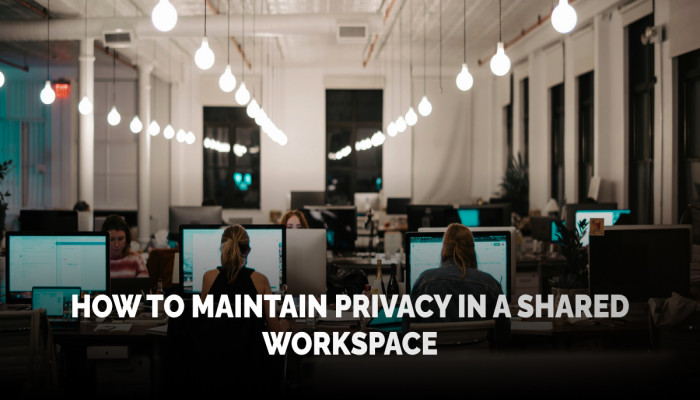 Launch apps instantly. Claim $200 credits on DigitalOcean
Launch apps instantly. Claim $200 credits on DigitalOcean
How to Maintain Privacy in a Shared Workspace?
Written by Jarral » Updated on: March 12th, 2024

In today’s world shared workspaces have emerged as a diligent solution for professionals seeking flexibility and collaboration. When it comes to maintaining privacy, With several advantages, these shared workspaces have many unique challenges.
In this article, we’ll be sharing the challenges being faced in shared workspaces and what are the strategies to tackle the given challenges in maintaining privacy.
The Rise of Shared Workspaces
Because of convenience, cost-efficiency, and collaborative atmosphere, these shared workspaces have witnessed a huge rise in popularity.
Different entrepreneurs, freelancers, and even established companies are drawn towards these coworking spaces as they offer environments including meeting rooms according to their needs and requirements.
Nevertheless, amidst this surge, privacy concerns have become a vital consideration. Privacy is always important in every field whether you are a freelancer, entrepreneur, software developer, or website developer.
Challenges Faced in Shared Workspaces
There are a lot of challenges but the most important ones are as follows;
Acoustic Privacy:
The open layout of shared workspaces often leads to sound carrying across the room, inadvertently exposing confidential discussions, which is a big concern for individual workers like data analysts, blog writers, and programmers.
Visual Privacy:
The absence of private offices means that computer screens and documents are visible to neighboring coworkers, potentially compromising sensitive information. Most coworking spaces have been designed in such a way that they just have flex desks which is not appropriate for today's workers.
Data Security:
Shared Wi-Fi networks and communal printers can uncover devices to security risks, making data vulnerable to infringements.
This means the data travels ‘naked’ across the network which makes it easy for hackers to intercept it. Hackers can easily access data sent to printers which includes documents with sensitive information.
Personal Space Management:
Managing personal belongings securely can be challenging, and without personal offices potentially leading to loss or theft. These spaces often provide individual spaces with limited storage space which makes it difficult for clients to ensure the security of their personal belongings but it possible at indibloghub.
Best Strategies to Maintain Privacy
The following are the best strategies to maintain privacy in shared workspaces;
Privacy Screen Filters:
Anti-glare and privacy screen filters for monitors and laptops prevent unauthorized viewing, shielding sensitive information from prying eyes. It will keep sensitive information safe from other coworkers.
Designated Private Zones:
Utilizing designated enclosed spaces or soundproof booths for meetings ensures confidentiality and reduces distractions. Shared workspaces should be designed with designated private zones to keep the discussions confidential.
Data Encryption and VPNs:
Encryption techniques and Virtual Private Networks (VPNs) should be employed in the workspaces to enhance the security of data transfers and communications.
Soundproofing Solutions:
Implementation of sound-absorbing panels in these spaces to prevent sound leakage and maintain confidential conversations will make coworking easy.
Secure Storage Solutions:
Integrate lockable cabinets or drawers to store documents and personal items, minimizing the risk of theft or loss. Every client should have a specific storage space for their personal belongings.
Best Practices for Privacy in Shared Workspaces
- Selective Sharing: Exercise discretion in sharing information and limit collaboration to the essentials to prevent sensitive data exposure. Data should be shared with only those who have a legitimate business reason to access it.
- Device Security: Strengthen device security with strong passwords, biometric features, and regular software updates. One should implement strong passwords, and multi-factor authentication to limit access to their data.
- Understanding Privacy Policies: Familiarize with the workspace's privacy policies and ensure alignment with privacy requirements. Transparency in data handling builds trust with users. Knowing the privacy policies allows you to explain to others how their data is being handled within the workspace.
- Communication Etiquette: Utilize designated areas for private conversations, employing hushed tones and respectful communication practices. Effective communication is way more important in any collaborative environment. Professionalism and privacy are both equally important in shared spaces. This is where communication etiquette comes into play.
Conclusion
Shared workspaces are undeniably transforming the modern work culture, offering flexibility and collaboration like never before. However, the need to maintain privacy in these shared workspaces cannot be overlooked.
By melding a blend of physical precautions, digital security measures, and thoughtful practices, people and businesses can achieve a harmonious balance between collaboration and protecting sensitive data, ensuring that shared workspaces remain both productive and secure.
Copyright © 2024 IndiBlogHub.com Hosted on Digital Ocean









Post a Comment
To leave a comment, please Login or Register